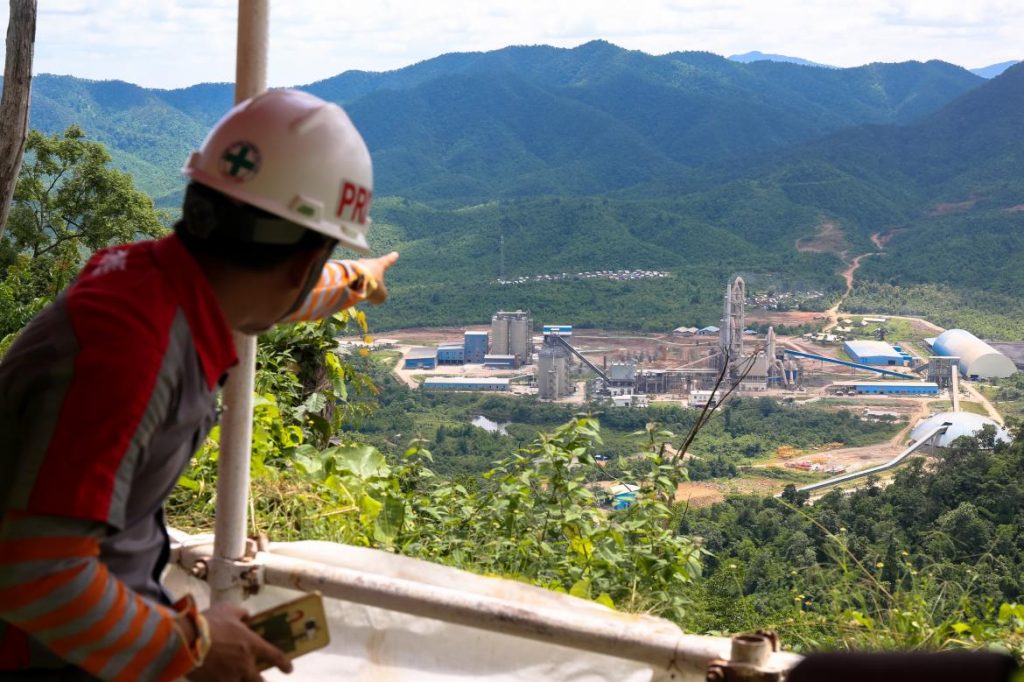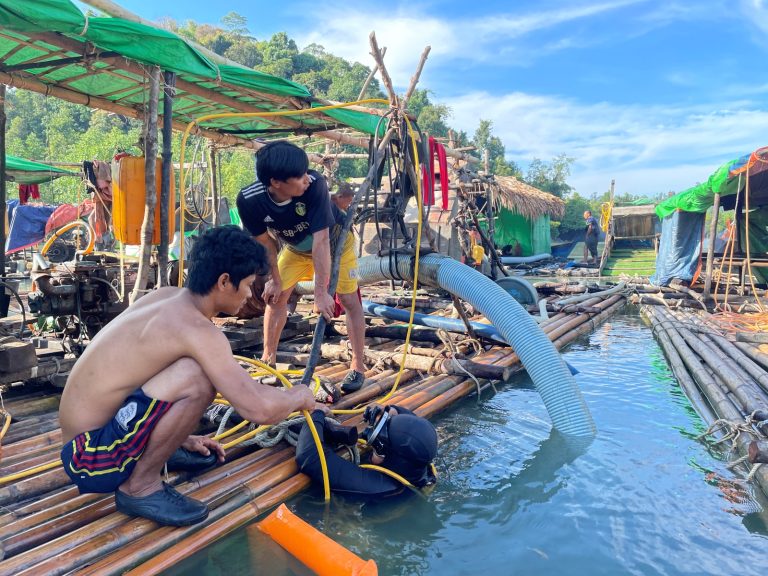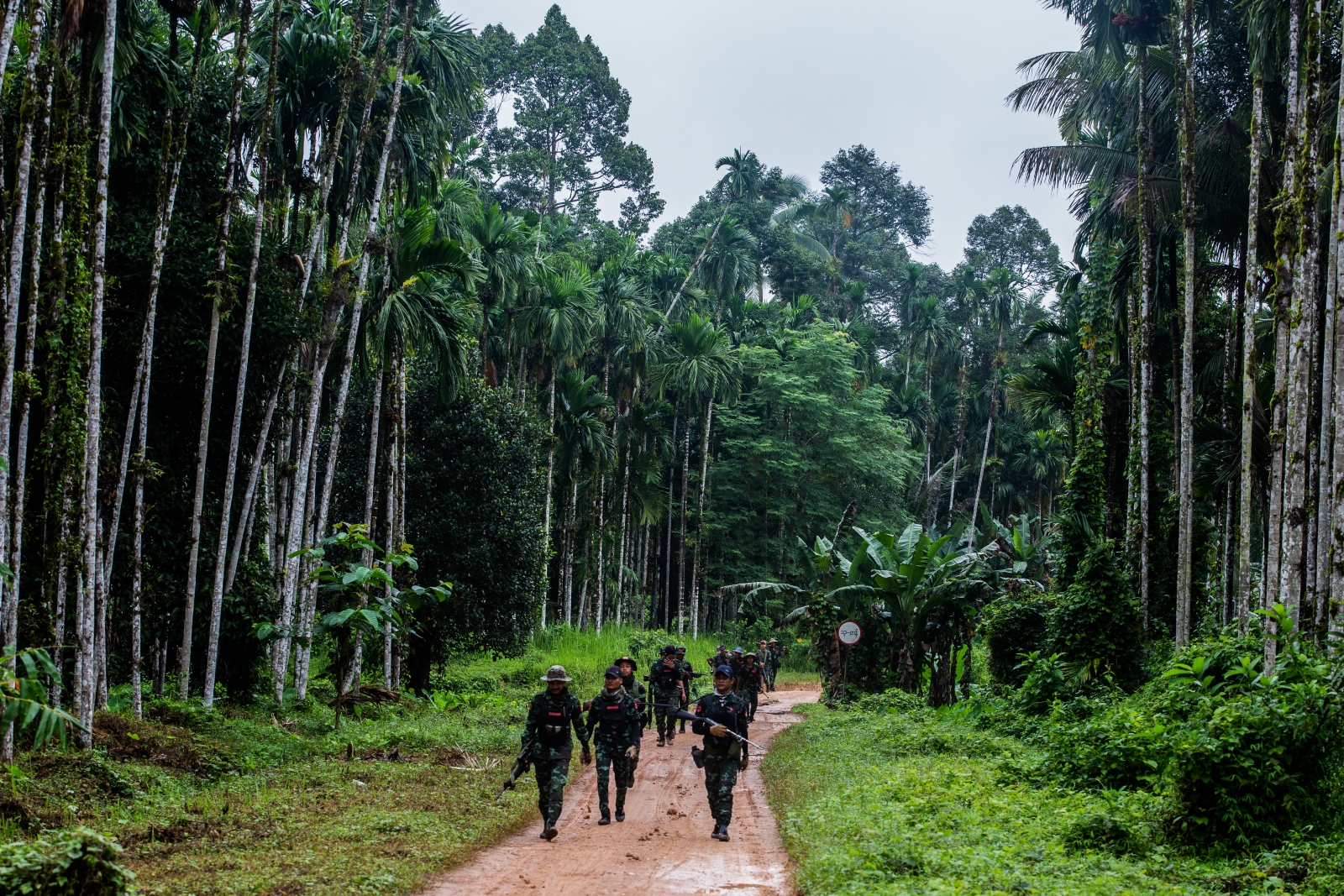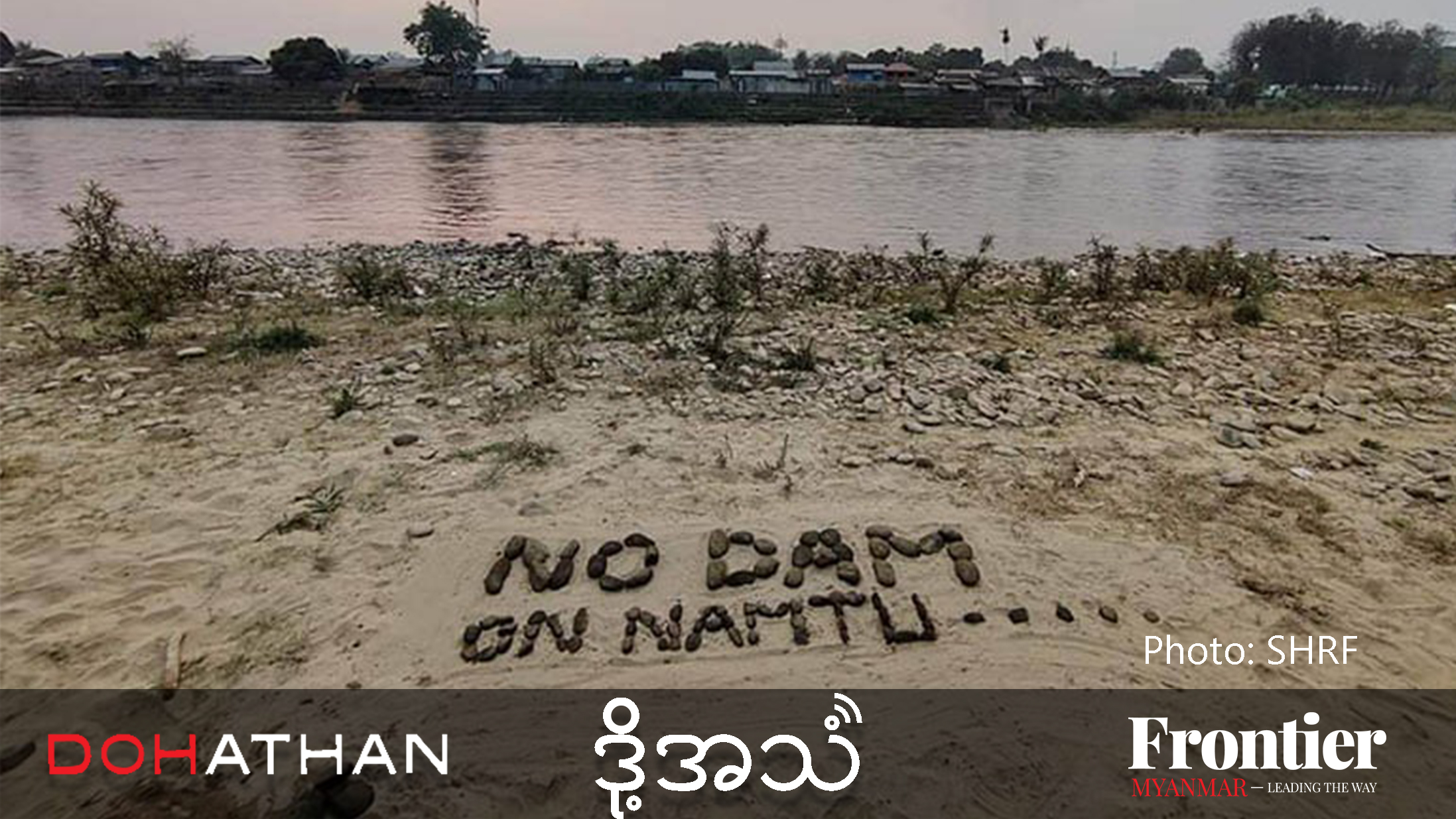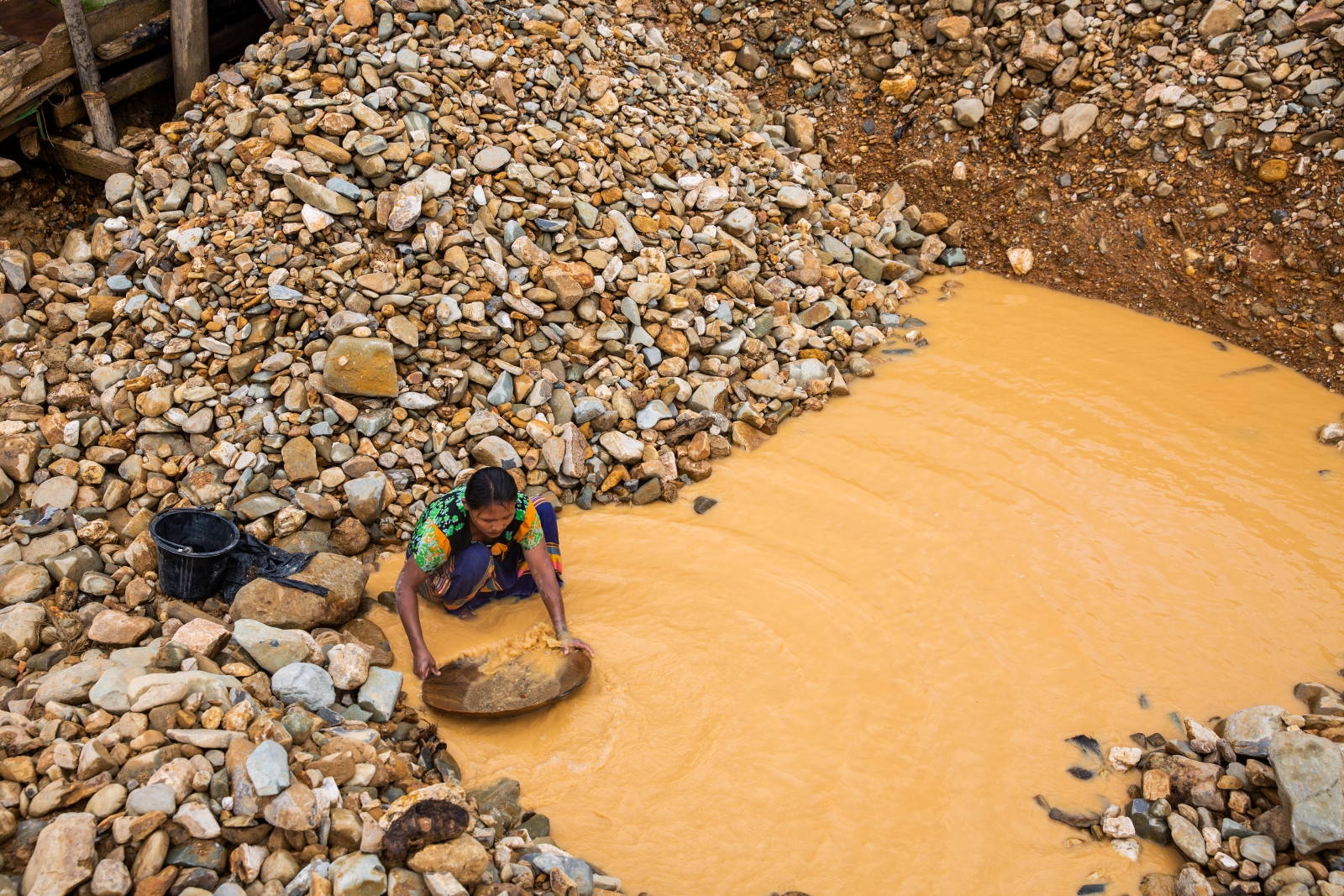The proposed expansion of a Shwe Taung cement plant in Tharzi has run up against opposition, but supporters of the International Finance Corporation-backed project argue it will raise standards in the sector.
By SU MYAT MON & VICTORIA MILKO | FRONTIER
KU PIN resident Ma Khin Nyo walks out of her house holding her child. The young boy is covered in red bumps and open sores.
“It happened to my son soon after he was born. I think it happens because of the water we use to shower him,” Khin Nyo said. “Even though we apply medicine it is not cured yet and I don’t know what to do.”
Residents in Ku Pin, in the far east of Mandalay Region’s Tharzi Township, attribute the skin ailments to dust and debris from the recent expansion of a nearby cement plant just a few kilometres south of their homes.
The health issues are one of a number of complaints area residents have leveled at the plant operator, Shwe Taung Cement, a subsidiary of the Shwe Taung conglomerate headed by Wa businessman U Aik Htun.
cementmilko-26.jpg
Support more independent journalism like this. Sign up to be a Frontier member.

A billboard for Apache, the Portland cement subsidiary brand of Shwe Taung Group. (Victoria Milko | Frontier)
The project has come under intense scrutiny after the International Finance Corporation, the for-profit arm of the World Bank, proposed taking a US$15 million equity stake in the project and lending another $20 million. The money would be used to support a $110 million expansion of the plant that would increase clinker production from 1,500 to 5,500 tonnes a day, and cement from 2,800 to 7,200 tonnes a day.
The project had been expected to go to the IFC board for approval in early June, but this was pushed back to late July. On July 31, the project received the green light – but not without dissent from some board members.
The Shwe Taung town
Walking through Pyin Nyaung, a village about 6 kilometres south of the plant, it’s hard to miss Shwe Taung’s presence. At the western entrance, visitors are greeted by a large, dusty billboard advertising Shwe Taung’s Portland cement brand, Apache. Closer to the centre of the village, the name “Shwe Taung” is stamped across everything from children’s backpacks to a freshly minted water storage facility.
stg-tharzi-map.jpg

But some in Pyin Nyaung are also upset at the project, claiming that Shwe Taung took their land years ago and still hasn’t paid compensation.
The residents of Pyin Nyaung are no strangers to land disputes; in 1983, they said, the socialist government began seizing acres of land in the village, which is on the Tharzi-Taunggyi Highway, about 15 kilometres from the border with Shan State. In 2008, much of the land was given to private companies to develop into cement factories, taking advantage of the nearby limestone hills that mark the edge of the Shan plateau.
cementmilko-15.jpg

Ma Khin Nyo from Ku Pin village holds her infant son. She blames the dust from the cement plant for causing the skin ailment. (Victoria Milko | Frontier)
To the south of Pyin Nyaung, conglomerates Htoo and Max Myanmar also run cement plants, the latter leased from Yangon City Development Committee, according to Max Myanmar’s website.
Despite the many confiscations, the villagers were always too intimidated to speak out. But in 2012, activists started taking advantage of new political freedoms to campaign for the return of land, and some of it was indeed given back.
A fight in the night
A few kilometres west of the village entrance and the Apache sign, Pyin Nyaung resident Mya Oo takes the turn-off to the cement plant. He pulls to the side of the road, gets out of his car and walks into the greenery on the verge. After a few steps the foliage quickly disappears, opening up to a barren plot of land. When Mya Oo owned this land, the fields contained banana, jackfruit and mango trees.
On the night of April 7, 2015, Mya Oo was at home with his family in Pyin Nyaung when he received a message from some other residents: two Shwe Taung employees were bulldozing some of his land.
“My son and I rushed to the spot to stop them,” he said. “In the end, a fight started with the two men.”
cementmilko-41.jpg

U Mya Oo holds a photo showing his fields after they were cleared by Shwe Taung employees. (Victoria Milko | Frontier)
They apprehended one of the men and marched him to the home of the village administrator, U Sein Hlaing. His daughter answered that her father was not there.
But Mya Oo’s son, Ko Aung Oo, saw the administrator, and responded: “Fucking U Sein Hlaing is there.”
They went to the police station, but Sein Hlaing had beat them there – and was filing a case against Aung Oo for cursing at him. Aung Oo was found guilty and sentenced to seven days’ imprisonment. Mya Oo estimates that the family spent K2.5 million defending him in court.
Mya Oo holds a land use certificate for the land known as “form 7”. Shwe Taung has what is known as “form 105”: a document that confirms it has paid tax on a particular piece of land. It acquired this in 2013, and said that at the time it thought the land was vacant.
The land question
Mya Oo lost five of his 24 acres when Shwe Taung took the land for a staff housing project. But he is far from alone; when Frontier arrived in Pyin Nyaung, we were greeted by around a dozen area residents, most from neighbouring Mone Pin and Ye Baung Sone village, who wanted to tell us about their land disputes with the company. Discussion of the details continued well into the night, long after everyone else in the village had gone to sleep.
U Sein Toke from Pyin Nyaung told Frontier that three of his 14 acres had been taken by Shwe Taung when the company widened the road, and he too had not received compensation.
Shwe Taung said that since 2009-10, 14 people from five villages received compensation related to road widening, while another four villagers were also paid for power lines being built on their land.
cementmilko-7.jpg

U Sein Toke plucks bananas from trees at his plantation near Pyin Nyaung. He says he lost three of his 14 acres when the road to the Shwe Taung plant was widened. (Victoria Milko | Frontier)
Shwe Taung chief executive officer U Aung Zaw Naing said the company believed it had paid compensation to all of those affected by land confiscations, “but the [new complaints] that are coming out at the moment might have been missed for some reason”.
Affected residents said the issue was simply fear and a lack of knowledge. Prior to the transition to the U Thein Sein government, they didn’t dare seek compensation when land was taken.
After the transition, when it became possible to complain, they didn’t know who to ask. Local officials, including village administrators and land registration officers, weren’t interested. “We inquired how to get back our land, but the authorities were not on our side,” Sein Toke said.
cementmilko-48.jpg

Shwe Taung manager for administration and HR U San Myaing at the cement plant in Tharzi Township. (Victoria Milko | Frontier)
Earlier this year, though, they linked up with the Myanmar Alliance for Transparency and Accountability, a civil society network working mostly on environmental issues.
Once MATA became involved in March, Shwe Taung moved quickly to open discussions with the villagers about compensation.
When no money was forthcoming in June, residents sent a complaint letter. In response, Shwe Taung arranged a public forum in Yangon on July 18 and invited Pyin Nyaung residents to attend.
Frontier was also invited to the forum. But when villagers began asking questions at the forum, Aung Zaw Naing requested that it be held behind closed doors.
Aung Zaw Naing would not discuss the results of the meeting but insisted that a satisfactory outcome had been reached between Shwe Taung and those who attended. Villagers claim that STC agreed to pay villagers by July 21; STC said there was no such agreement.
Instead, deputy managing director U Kyaw Naing Soe said Shwe Taung wanted to pay the villagers but that the disbursal was being held up by IFC guidelines, including the need to show proof of ownership.
“Otherwise, not being in line with the guidelines by the IFC, there will be holes,” said Kyaw Naing Soe.
However, IFC country manager for Myanmar Mr Vikram Kumar said IFC was not responsible for the delay in paying compensation to Pyin Nyaung residents.
‘We need to build trust’
Sitting in his office in Ahlone Towers, Shwe Taung CEO Aung Zaw Naing tries to take a positive approach. He told Frontier that the company hopes to move forward with the project in order to support development in Myanmar. “It would be easier for us to import cement from abroad and sell it in Myanmar, but we want to produce it ourselves to contribute to the country,” he said.
On the disputes with residents, Aung Zaw Naing said Shwe Taung wants to focus on ensuring “positive outcomes” rather than “looking back to the past”.
“Land ownership is a very complicated case in the country,” he said. “If they [residents] are really affected by the project, we will compensate them.”
He describes the disputes with villagers as a misunderstanding. “Since there is 50 years ahead to deal with the villagers,” Aung Zaw Naing said, “We need time to build relationships and trust, and we are ready for it.”
But he was less conciliatory when talking about the land dispute with Mya Oo. “I am also the one who has the right to defend myself for this case,” he said. “I think we [Shwe Taung] are the ones who should complain about them, as they sent the complaint letters to the chief minister of Mandalay region, Amyotha Hluttaw, forestry department and the mining network.”
Then he adds, “But when it comes to the conflicts, we do not want to focus on who is wrong or right.”
cementmilko-57.jpg

The Shwe Taung Group cement plant near Pyin Nyaung. (Victoria Milko | Frontier)
Since announcing plans to expand the Pyin Nyaung project, Shwe Taung has certainly adopted a more transparent and consultative approach than the majority of investment projects in Myanmar, not least those involved in cement production.
It has held four public meetings: two in November 2016, in Yangon and Tharzi, and two more last month, in Yangon and Pyin Nyaung. The minutes from these meetings – including who asked questions and the responses given by company officials – have been posted on the company’s website.
At the meeting in Yangon last month, Aung Zaw Naing said the main purpose was to share the results of the environmental and social impact assessments.
He insisted that Shwe Taung is committed to transparency and accountability. “There might be challenges and hardship along the way, but we think activities like this public consultation will be very helpful,” he said.
He explained that Shwe Taung had approached the IFC not to secure loans or investment, but in order to help the company execute the projects to international standards with as little impact on the environment as possible.
“If we wanted, we could just get a loan from a bank in Myanmar,” Aung Zaw Naing said.
Raising standards
For all the consternation over the project – and in contrast with many other large investment projects – none of the residents in Ku Pin or Pyin Nyaung appear to be calling for the project to be scrapped.
In fact, they draw favourable comparisons between Shwe Taung’s operation and the other two cement plants in the area, which are to the south of Pyin Nyaung.
Kumar from the IFC said many projects in Myanmar had legacy issues that needed to be resolved for them to move forward. While regulations for paying land compensation and evaluating environmental and social impacts have been enacted or improved in recent years, enforcement often remains poor.
He argues that the IFC’s involvement in the Shwe Taung expansion will improve the outcome, including for area residents.
“[The government] adopted these standards, but implementing these standards is a completely different ballgame unless you understand how this needs to be done, you can struggle to implement it,” Kumar said, “There are probably very few projects in Myanmar that even understand or know how to move towards implementation of these standards.”
Kumar said the IFC wanted to work with Shwe Taung to set an example of how all cement projects in Myanmar should be done in the future. He said it was important for Myanmar to produce its own cement, as importing the product would add further to the country’s trade deficit.
“It’s very easy for us to say, don’t take a tough project, and to say we shouldn’t touch these project. The projects we go for there’s an opportunity cost to IFC not engaging in projects in Myanmar. If we don’t engage we don’t make a difference,” Kumar said.
“Yes, this is a tough project but we really believe that this can have an impact on the cement sector in the country. That’s the main reason we’re doing it.”
Environmental effects
But not all members of the World Bank Group are convinced that IFC oversight is enough to justify the environmental impact of the project. When the project was put to a board vote on July 31, the US representative, executive director Ms Karen Mathiasen, voted against it.
In a statement posted on the Treasury Department’s website, the US outlined a range of environmental concerns. “The United States’ review of the environmental and social impact assessment report and supporting documents revealed gaps in baseline data for rare and endangered species as well as insufficient analysis and mitigation plans to address environmental impacts,” the statement said. It also noted that there was no emissions data for the coal mine and additional air quality data, “without which it will be impossible to effectively assess the project’s impact”.
cementmilko-20.jpg

Men sit and fish at Ku Paung Creek. (Victoria Milko | Frontier)
The environmental impacts of the existing plant are also a concern for residents of Ku Pin. Except during rainy season, the village is covered in a thin layer of dust from the nearby plant, they said.
But a bigger concern is water. Ku Paung Creek, which runs besides Ku Pin dries up during hot season; residents said this was because the plant was taking water from the creek, and did not happen before it was built.
Shwe Taung disputes this, saying it has not taken water from the creek in the past 12 months. Kyaw Naing Soe from Shwe Taung said most of the dust appeared naturally because of all the limestone in the area. Sometimes it is exacerbated by fires in the forest, he added.
“But we’d be lying if we said no dust is coming from the plant,” he said. “Of course, sometimes the dust is blown around in the wind.”
Ruling party tensions
The project has created tension within the National League for Democracy, particularly grassroots members and local lawmakers. Residents have lobbied their local Amyotha Hluttaw representative, U Kyaw Thiha (NLD, Mandalay-12), to help them get compensation for the land they lost.
They have been told they will be invited to a meeting with Kyaw Thiha, who chairs the Amyotha Hluttaw National Resources Committee, and officials from the environmental department in Nay Pyi Taw, but no date has been set.
They are unlikely to receive a warm welcome from Kyaw Thiha, who told Frontier that he supported the expansion of the cement plant and believed civil society and the media were “creating problems”. He said he doubted that those seeking compensation were really affected by the project, because they are quite far from the plant.
cementmilko-32.jpg

Bags of Apache cement sit next to a water tank donated to Pyin Nyaung by Shwe Taung. (Victoria Milko | Frontier)
“The project has no big environmental impact,” he said. “The government has approved it in order to support the development of the country. … The company is quite transparent from our point of view.”
Prior to the election, Kyaw Thiha was an unknown quantity in Tharzi. Having previously represented Pyin Oo Lwin in the Pyithu Hluttaw since 2012, he was parachuted into the Amyotha Hluttaw seat by the NLD leadership.
Pyin Nyaung villagers said they listened to NLD leaders’ advice to vote for the party, not the candidate, and overwhelmingly supported Kyaw Thiha as their upper house representative. Many now regret that choice.
“Kyaw Thiha never comes to meet us about this issue,” said U Thein Win, the head of the NLD office. “Now I just want to cut off the thumb that I used to vote for him.”
Instead, they hope the media can draw attention to their complaints, he said. “We need journalists to come here and reveal the truth about the situation.”
Where is the truth?
But Kyaw Thiha is not the only person with whom Pyin Nyaung residents are angry.
Administrator U Nyo Maung has been a staunch supporter of the plant since Shwe Taung first arrived in the area in 2008.
Residents believe he is being paid to support the project. When Shwe Taung officials have visited the village over the years, they have typically just gone to Nyo Maung’s home rather than meet other residents.
cementmilko-31.jpg

Pyin Naung village administrator U Nyo Maung. (Victoria Milko | Frontier)
It’s not hard to see why residents believe this. When Nyo Maung granted Frontier an interview, we met him at the village administrator’s office that Shwe Taung had built. As we entered, we walked past a water filter system provided by Shwe Taung. His desk was covered in Shwe Taung merchandise, including pens and a calendar.
Nyo Maung was both aggressive and defensive when discussing the cement project. Before we could sit down, he opened the conversation by complaining that we had not informed him we were visiting Pyin Nyaung.
He said he supports the project because he assumes it will bring development to the area. “The government has designed the project for the sake of development,” he said.
The company has already done many positive things, he said. Without Shwe Taung, there would be no high school, for example. “As you know, education is the most important thing for the community,” Nyo Maung said.
He got angry when asked which side he thought was telling the truth – those who support or oppose the project.
He held up his hand, his palm upright. “This is the truth I see,” he said, pointing to the back of his hand. He then pointed to the palm facing outward. “And this is the truth you see.”


